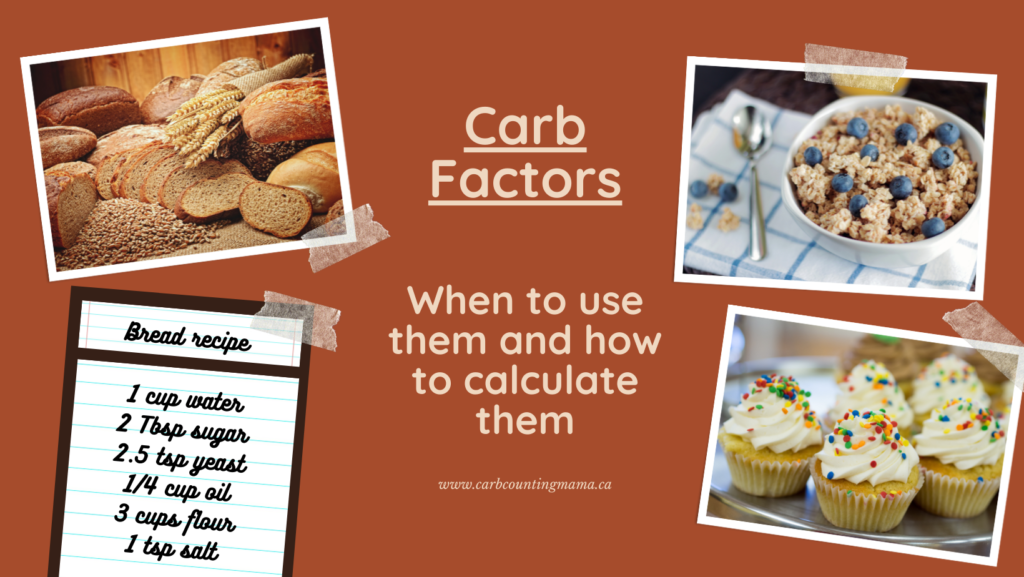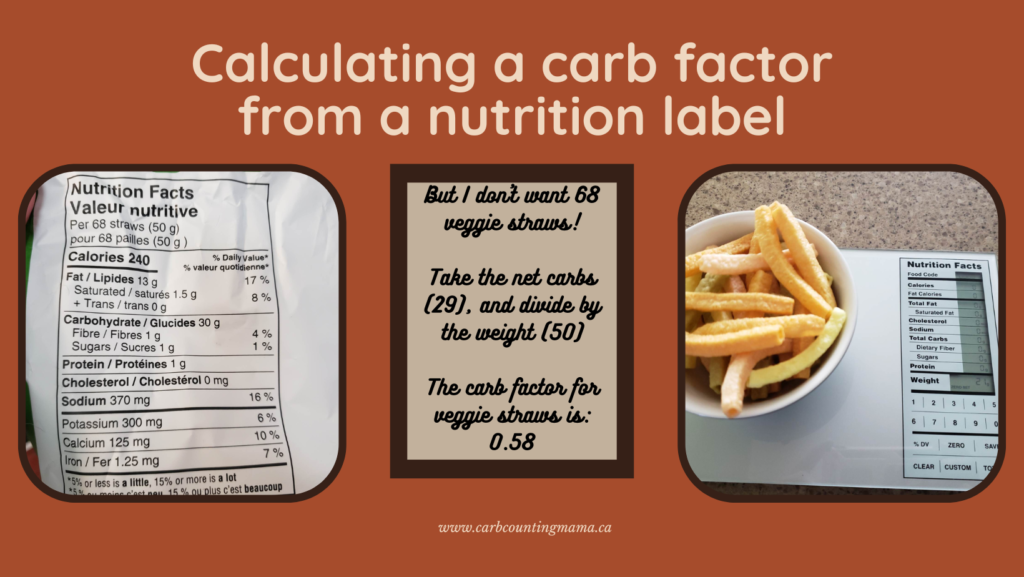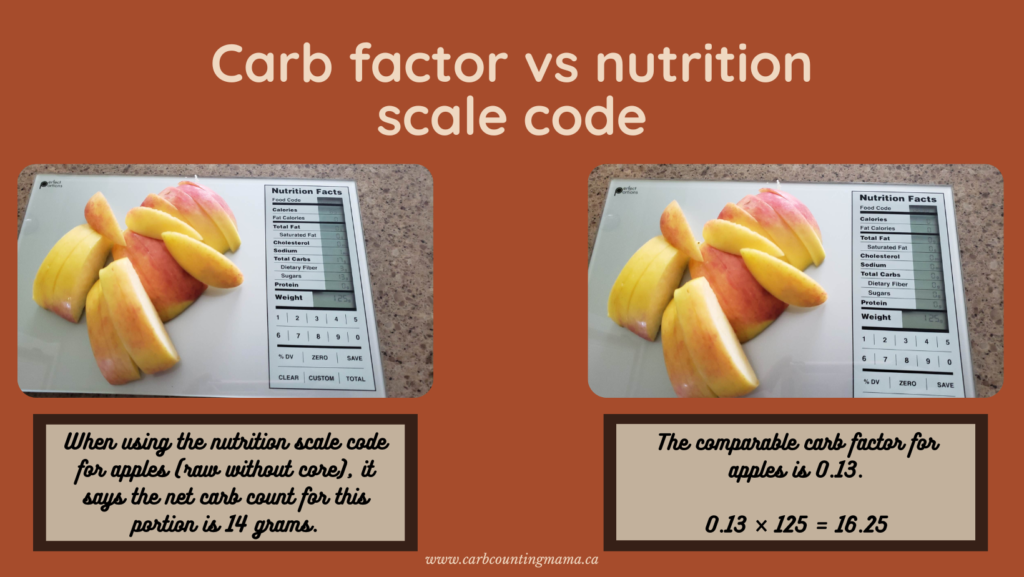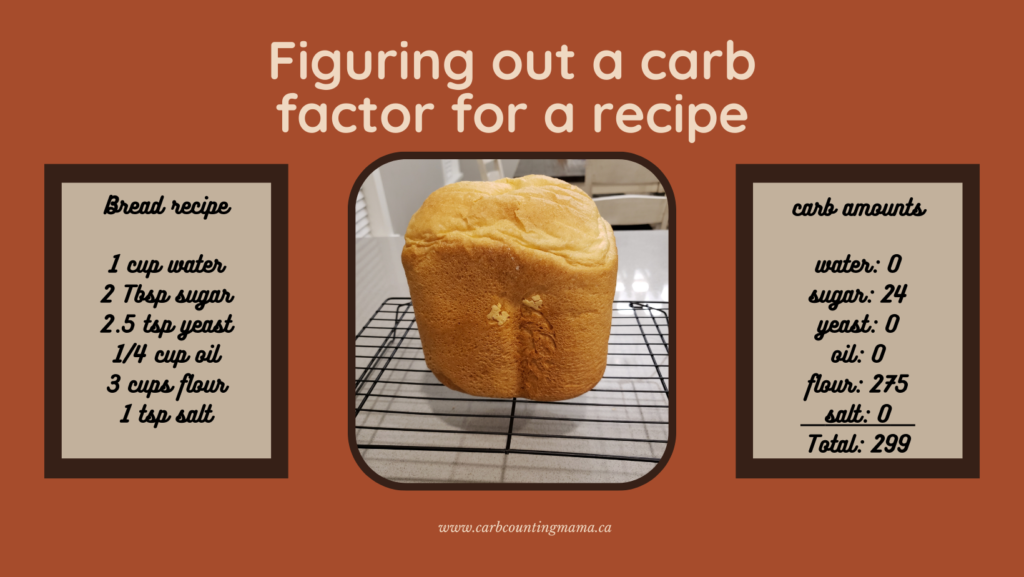Do you know what a carb factor is? If your answer is “no” don’t worry! Lots of people in the T1D community haven’t even heard of carb factors before. But, they can be a really helpful tool for insulin dosing. All you need is a nutrition scale and the nutritional information for your food. Don’t have the nutritional information? There are ways around that. Let’s go over what carb factors are, how to use them, and how to calculate them for your favorite recipes!

This post contains affiliate links
What is a carb factor?
Some people mistakenly think that carb factors are the same thing as carb ratios. These two things are completely different and are not synonymous in any way.
Unlike most of the numbers that we use for T1D math, carb factors are attached to the food item rather than the individual person using them.
A carb factor tells us what percentage of a given food is carbohydrates. As they represent the percentage of one gram of food, carb factors are always a number between zero and one.
It’s a very simple calculation that can come in really handy for people with T1D when they’re trying to figure out insulin doses.
Why are carb factors useful for people with T1D?
It’s important for people with T1D to carb count. That’s a fairly simple task when we have nutritional information readily available, but what if we don’t?
After accurate basal and prebolusing, accurate carb counts are one of the most important aspects of T1D management.
But there are lots of foods that are a bit tricky to figure out the carb count. Homemade foods, things without nutritional labels like fruits and veggies, and even foods with nutrition labels that aren’t pre-portioned like cereal or chips, to name a few.
When you know the carb factor for these kinds of foods, you can properly calculate the carb count rather than SWAGging it. Estimating the carb count adds a lot of room for error. So, if there’s a simple way to get an accurate carb count, it’s probably a good idea to do that instead of guessing.
Before we get too far into it, in order to use carb factors, you need a nutrition scale. This is all based on the weight of your food.
Where can I find carb factors?
Carb factors and nutrition labels
It’s fairly easy to get a carb factor from a nutrition label. You simply take the net carbohydrate amount and divide it by the portion size in grams.
If the nutrition label doesn’t provide grams, you can either use your food scale to get that piece of information, or you might be able to look up the carb factor for the type of food you’re eating.
But if you have the nutrition label, why would you need a carb factor?
There are lots of foods that we want to eat without having the specified portion size. A bag of chips tells you the carb count, but what if you don’t want that amount of chips?
Yes, you can use cross-multiplication to figure out the carb count for the portion that you’ve poured. And that’s probably the best way to go if you don’t often eat that food. But what if you have a bowl of cereal in the afternoons, or some chips when you’re watching TV every night? Figuring out the carb factor and keeping it somewhere handy might be easier.

Let’s figure out the carb factor for this bowl of veggie straws.
As you can see, the nutrition label is for a serving size of 68 veggie straws. That’s quite a lot! I don’t want to eat that much.
So, let’s take the net carb amount (29) and divide it by the weight (50). That gives us a carb factor of 0.58.
Now when we pour the amount we want to eat and weigh it, all we have to do is multiply the weight by the carb factor. In the image above, the bowl of veggie straws weighs 21g (make sure to zero out the plate or bowl first!).
21 × 0.58 = 12.18
There are approximately 12 grams of carbs in that serving of veggie straws. And if you frequently snack on veggie straws, you can keep the carb factor of 0.58 handy so that you can quickly figure out the carbs in any portion size.
Foods without nutrition labels
For foods without nutrition labels, there are a couple of ways to get the carb factor.
There are online lists available with common foods and their carb factors.
Or, if you have a nutrition scale that comes with an app or codes, it will give you the equivalent of a nutrition label when you weigh your food. Once you have the nutritional information, it’s the same quick calculation to get the carb factor.
But, carb factors can vary a bit too.
Let’s take apples for instance.

Is it based on a whole apple with a core? With or without the apple skin? These things could change the carb factor that you should be using. Different carb factors for apples range from about 0.10 to 0.15.
I found a carb factor online for cored, seeded, apples with peel: 0.13.
When you take the weight, in this case, 125 grams, and multiply it by the carb factor, you’ll get the number of carbs in that portion. This one happens to be 16.25 grams.
According to the carb factor, that portion of apple has approximately 16 grams of carbs in it. When I used the “apple” code from the scale’s nutrition guide, it gave me a similar, but different, carb count. It showed that portion has 17 grams of carbs, with 3 of those being fiber. So, 14 net carbs.
Carb factors and nutrition scale codes are both generalized. Both can vary, but they should give you similar numbers. It’s up to you to decide which number you think is more accurate.
How to calculate a carb factor in recipes
Recipes can be a bit more work, but it’s worth it to calculate the carb factor once if it’s a recipe that you use often.
Here’s how you do it:
- Calculate the net carb amount for the recipe by adding up all of the carbs, minus the fiber, in each ingredient.
- Weigh your finished product.
- Take the first number and divide it by the second number.
That’s it. That’s the carb factor for that recipe.
Still not sure how it works? Let’s go through a recipe together!

This bread recipe has 299 grams of carbs for the whole loaf. And when we weighed the loaf, it weighed 659 grams. 299 ÷ 659 = 0.45. That’s your carb factor.
Now, when we use that recipe and cut a slice of bread, we can weigh it and multiply it by 0.45 to get the carb amount for that specific piece of bread. And that’s a really good thing, because I can never cut bread properly and the slices are never the same!
Of course, the more ingredients your recipe has, the more work it can be to figure out the carb factor. But again, if it’s something that you make often, it might be worth the extra effort upfront so that you can simply weigh your portions later.
A few pointers and reminders
- Carb factors are specific to the food, not the person. They are not the same thing as carb ratios or carb targets.
- Carb factors will always be a number between zero and one. If you get a different number, something went wrong with your calculation.
- Most bread products have a carb factor of around 0.50 give or take. So keep that in mind if you’re calculating bread, croissants, muffins, etc.
- Carb factors use net carbs, not total carbs.
- If you dose for protein and fat, you can use the same method to figure out protein factors and fat factors as well!!
Carb factors aren’t a necessary part of carb counting and T1D management, but it’s good to know that they exist and that they can be useful in certain situations. It’s just one more tool for your T1D toolbelt!
Happy Carb Counting!
~ Leah
Do you use carb factors to help calculate your insulin doses? Are you going to start using them? Leave a comment below!
For more tips and stories about T1D, join the Carb Counting Mama email list, and make sure to head over to the Carb Counting Mama Facebook page and “like” it.
Leave a Reply